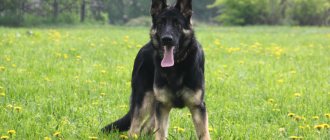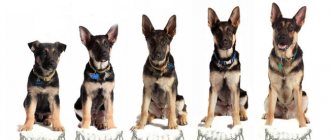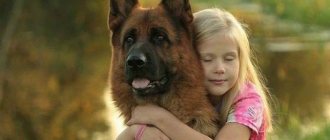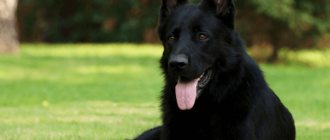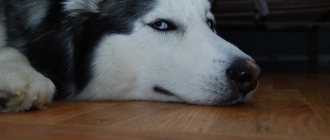The history of the origin of both breeds - the difference
HO and VEO are similar in appearance.
The German Shepherd (HO) was bred in the 19th century on the Scandinavian Islands. Thanks to its endurance and beautiful appearance, the breed has become popular in Europe, especially in Germany. At first, these dogs were used to guard the herd, later - for service and search. Currently, the “Germans” serve in the army, police, at the border, and help employees of the Ministry of Emergency Situations.
The East European Shepherd (VEO) is the pride of Soviet breeders. At the beginning of the 20th century, German shepherds entered Russia. They could hardly endure harsh weather conditions, were frozen in the North, and suffered from the bright sun in the South. Then Soviet scientists began work on creating a more hardened and larger breed. By crossing the German, Caucasian Shepherd and Laika, the East European Shepherd appeared.
The current situation of representatives of these breeds
The German Shepherd is a breed recognized throughout the world. The quality of the population is closely monitored by specialists, and breeding is under the control of all international canine organizations.
The East European Shepherd as a breed is recognized by the Russian Kennel Federation (RKF), the International Kennel Union (IKU) and the International Union of Kennel Clubs (UCI). It remains unrecognized by the International Canine Association (FCI). Perhaps this is a matter of time, but for now the prevalence of the East European Shepherd as a breed remains within the post-Soviet territories.
TEXT_LINKS Today you can find a puppy for purchase from breeders from the National East European Shepherd Club, where there are contacts of devoted fans of this wonderful breed.
What is the difference between a German Shepherd and an Eastern European one?
If you look closely at the 2 breeds, it becomes clear how they differ from each other.
The main difference is the size of the dogs. “German” is squat and lighter. Adults reach a height of 55-65 cm, their weight is 30-40 kg. The height of East European Shepherds reaches 70 cm, and their body weight is 30-60 kg. Description of breeds:
- Body - VEO has a straight back with a slightly convex loin, BUT has a sloping croup, the back has a noticeable slope to the base of the tail.
- Head - if you look closely, you can distinguish dogs by their muzzle. Despite the fact that both breeds have a wide skull with a wedge-shaped, narrowed head. But the “easterners” have a more massive head, and the muzzle is much larger than the skull. The “Germans” have a light head, a muzzle proportional to the skull.
- BUT's eyes are almond-shaped and dark in color. VEO's are oval, preferably black, but the standard allows for the iris to be lightened to match the color of the coat.
- The tail of the “Germans” is arched, and when moving it does not rise above the back; among the “Easterns” it is saber-shaped; when running, the dogs keep 2/3 of it at the level of the back, and the upper part is bent to the side or upward.
- Hair coat – the breeds have a dense coat, with coarse hair and a thick undercoat. But the “Germans” have short hair on their front legs and long hair on their back legs, as if the dog is wearing pants. VEO has short hair on all limbs. "Germans", unlike "Europeans", can be smooth-haired or long-haired.
- Color – 90% of dogs of both breeds are born with a saddle color. But NO has bright shades, rusty red or yellowish brown. In VEO, the saddle cloth is located on a lighter background. The colors that cannot be used to distinguish between breeds are zonal and black.
“German” can be recognized by its sloping croup
. Color variety:
- saddle cloth - large dark areas on the back in the form of a mantle that goes down to the elbows and sides, a mask on the muzzle;
- black – rare color;
- zonal – original color. The base is ash color. A special feature is the ring color of the hair.
Light, white and pure red color are considered defective. Such dogs are not suitable for exhibition work and breeding.
Important! The “Germans” move freely, the “Europeans” move at a fast gait.
The life expectancy of the East European Shepherd is 10-16 years, for the “Germans” it is 10-14 years.
Comparison by behavior
Breeds can also be distinguished by their behavior. Character of BUT:
- attentive, obedient;
- brave;
- wary of strangers;
- ready to attack the enemy on command;
- in the family circle, calm, friendly;
- gets along well with everyone in the household.
Personality of East European Shepherds:
- “Easterns” are calm and balanced;
- the service is treated with full responsibility;
- have a strong protective and watchdog instinct;
- are intelligent and have a good memory;
- overly independent and stubborn;
- Children are surrounded with care and affection.
Important! By temperament, the “Germans” are choleric, and the VEOs are phlegmatic.
Ability to train
Both breeds are intelligent and highly trainable. But due to the difference in character, dogs respond to training in different ways. Raising German Shepherd puppies is not that difficult. They perceive training as a game, which is why the breed achieves heights in complex training programs. Pets tirelessly master one command after another, obey unquestioningly, and easily learn complex commands.
VEO is calmer and more self-possessed. Training will not be troublesome for her; the puppy will perceive it as work, not play. But due to his stubbornness, the pet reluctantly grasps commands and needs more time to complete them. “Vostochnik” works tirelessly, and with long training you can achieve the desired result.
“Easterns” are calm and restrained
Important! With proper training, both breeds produce loyal, hardy and reliable dogs. But in sports competitions, VEO champions are not often found.
“Germans” are more suitable for an apartment, since a more powerful “Eastern” will not be comfortable in a confined space. It is better to keep such a dog in an enclosure.
Difference between German and East European Shepherd in terms of working qualities
“Germans” are flexible and suitable for any professional and sports discipline. Easterners are born watchmen and security guards; they have difficulty mastering other jobs.
When detaining an offender, the NO tries to catch up and capture him at any cost, often without listening to the owner’s commands. The "German" is hardy - it can follow the trail tirelessly for several hours. VEO is more reasonable and wary, so it quickly switches at the owner’s command. The dog gets tired quickly and can chase an intruder for no more than an hour.
Important! VEO is an excellent guide, and the “Germans”, due to their emotional and hot-tempered nature, are not suitable for this work.
Who is more picky about feeding?
BUT you can give premium industrial food. Also, they will not refuse natural products. Combining dry and natural food is prohibited. Otherwise, the dog will have health problems.
Veterinarians recommend feeding “Eastern dogs” fractionally and exclusively with natural products. The diet should include: fresh lean meat, eggs, dairy products, fresh vegetables, fruits, herbs and offal. Once a week it is useful to give your dog beef bones and cartilage.
German and East European Shepherd - differences in price
You can buy a puppy of both breeds for 30-50 thousand rubles. The price will be much higher for a show-class German Shepherd puppy, especially from imported parents. The cost depends on some factors:
- purebred;
- age and gender characteristics;
- color and compliance standards;
- presence of pedigree.
The East European Shepherd is less in demand. The number of the breed is gradually decreasing; dogs are often bred only in Russia and the CIS countries.
Breeds in modern times
In the modern world, the service qualities of shepherd dogs, as well as their character and high ability to learn, are highly valued. Germans are popular all over the world, they are actively bred and all breed characteristics are supported. There are clubs and nurseries anywhere in the world, the cost is quite stable and depends on various indicators.
Veo - unfortunately not recognized by the cynological federation, has no official standard and is widespread mostly in the Russian Federation and the countries of the former CIS. That does not prevent her from serving on the border, living with families and feeling great next to a person.
East European and German Shepherd mix
Often, to improve performance, dog handlers cross a “German” with an “Eastern”. The mixed breed is large in size, males reach 75 cm and weigh up to 60 kg, females are smaller - up to 70 cm, and weigh up to 55 kg.
The German-European Shepherd is harmoniously built: its back is straight, with a slight slope towards the base of the tail, the chest is powerful, the tail is lowered down, the limbs are straight and high. Mestizos can be black, zoned, or saddle-backed. Often there are dogs with a mask of gray and red color.
The puppy takes its temperament and character from both parents. The puppies are not inferior in appearance and working characteristics to their purebred parents. They are good guards and protectors, are highly trainable, and get along well with children and other pets.
Important! This dog is not suitable for breeding and exhibition work.
In order for the mixed breed to feel comfortable and not suffer from diseases, it is better to keep him in a country house, since due to its large size, the dog will not be comfortable in the apartment.
Exterior differences between two shepherd dogs
It's quite easy to tell the two dogs apart. VEO – larger, wider with a straight back line, long paws, tall. Differences in height at the withers, about 10 - 12 cm. Eastern European females correspond in size to German males.
- Weight differences: the German is 10 - 15 kg lighter.
- The German Shepherd is the owner of a bright inclination of the spin line by 20 - 25 degrees. Eastern Europeans do not have such a slope.
- The chest of the Eastern European is wider and deeper, the paws are larger and wider, and heavier. The movements are wide and sweeping, strong and quick pushes from the support. German - moving at a trot.
- Colors: Europeans have more quantity and variety in acceptable standards. It can be red, zonal, zonal-gray, black-gray. German representative according to the standard: the owner of a clear mask on the face, black and gray-zoned in color.
Veo or German, who to choose?
Both dogs are perfectly manageable with ideal service characteristics and behavior in general. Both have decent character, without excessive aggression, aimed at interacting with people.
Caring for both breeds is identical, including: proper and balanced nutrition, grooming, hygiene, physical activity, education and training, as well as a vaccination regime.
HO and VEO adapt well to different climatic conditions, but Eastern Europeans are more inclined to live in cold climates. They can live both in a house and in an apartment and in enclosure conditions.
But - it is suitable for more active people, athletes, young families, singles. Veo - for a more family-friendly lifestyle and a relaxed lifestyle, although it is larger than BUT.
Both pets require sufficient physical activity, a constant educational process, and a person with a strong character who can provide proper maintenance.
Types of crossbreeds and their descriptions
One example of crossbreeds is a crossbreed between a Caucasian and a Central Asian Shepherd . Many believe that these two breeds are closely related, which is manifested by the presence of similar features in appearance and behavior. However, dog breeders use representatives of these species to produce strong and strong puppies. Children from such “marriages” turn out to be massive, powerful, and their appearance is more similar to the Caucasian Shepherd Dog.
Puppies have thick and strong muscular legs, a long and bushy tail, which is often docked. The coat is thick, long, with a good undercoat layer, forms a “collar” around the head, and covers the rest of the body more evenly. It comes in the following colors: white, dark brown, gray, red or beige.
Stafford and German Shepherd hybrids are distinguished by their unpredictable nature, high fighting skills, increased aggressiveness and stubbornness. At the same time, they are medium to large sized dogs, similar in appearance to the Staffordshire Terrier. The coat is usually short and does not cause any problems for owners. It is not recommended to have such dogs if there are children in the house.
St. Bernard and Shepherd mixes are not so common, but this does not mean that they are not popular. These are large dogs with a somewhat intimidating appearance, however, by nature the dogs are calm, balanced, and stress-resistant. Such dogs are excellent protectors and guards, as well as simply loyal friends.
Puppies from Chihuahuas and German Shepherds grow into small dogs; rather, they can be classified as small (if the Shepherd genes predominate, then the growth is slightly higher). Such dogs feel great in apartment conditions, love to play, are sociable, smart and obedient.
Crossing a Pitbull with a German female produces some pretty cute puppies. They are characterized by calmness and pronounced protective properties. Most often, the coat color is brown, there may be black spots, and the dogs have dark eyes.
The “marriage” of a boxer and a German woman gives birth to cute, medium-sized puppies that love children, are distinguished by their friendliness and high watchdog properties. However, such dogs can be stubborn.
Malamutes, when mixed with Huskies and German Shepherds, produce unusual offspring. In appearance, the mestizo can be mistaken for a wolf, however, the dog is not at all as dangerous as it might seem. These dogs are friendly and get along well with children; their character is calm and balanced.
The Rottweiler can also be crossed with a German. The offspring are characterized by the following features: they are large animals, characterized by curiosity, calmness, activity and mobility, and self-confidence. Such dogs may show attempts to dominate the house in relation to other animals and even their owners. The dog performs protective and security work well.
Hybrids of the West Siberian husky and shepherd dog are large and hardy animals, capable of performing various tasks, including the role of a sled dog. These are very loyal pets to their owner, with a keen sense of smell and hearing. Among the disadvantages of dogs, it can be noted that they can run away, do not obey well, are wayward and have little tendency to learn.
A cross between a Belgian (Malinois) and a German Shepherd is well suited for military service. They are often red in color and somewhat smaller in size than the German, which they also resemble in character. These are hardy animals that can quickly develop running speed. Therefore, they are highly valued in police services.
Doberman and German mixed breeds have certain negative aspects. For example, they do not tolerate loneliness well, need high physical activity, react poorly to other animals in “their” territory, and have an aggressive appearance. However, there are also a lot of positive aspects: dogs get along with children, are quite calm and intelligent, are easy to train, are obedient, and do not show unreasonable aggressiveness. Such mestizos have high guard and protective potential.

